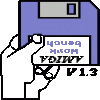Ok.
Lets say i have a sprite that have a weight * gravity.
How do you best code some "random" input force on the sprite?
Do you code the force like a particle system, min-force, max-force, force direction, and delta time the force has to develop.
Basically i am coding a small flight game and i want to simulate different wind-forces affecting the airplane.
I know how to do this, but i dont know if i am doing a good coding pattern for this.
airplane has 4 forces = lift weight drag and thrust.
I want to simulate a small wind force blowing the airplane up, i don´t want to include this is my basic formula for flying. I just want to push the airplane around i guess.
How would your approach be for this?












